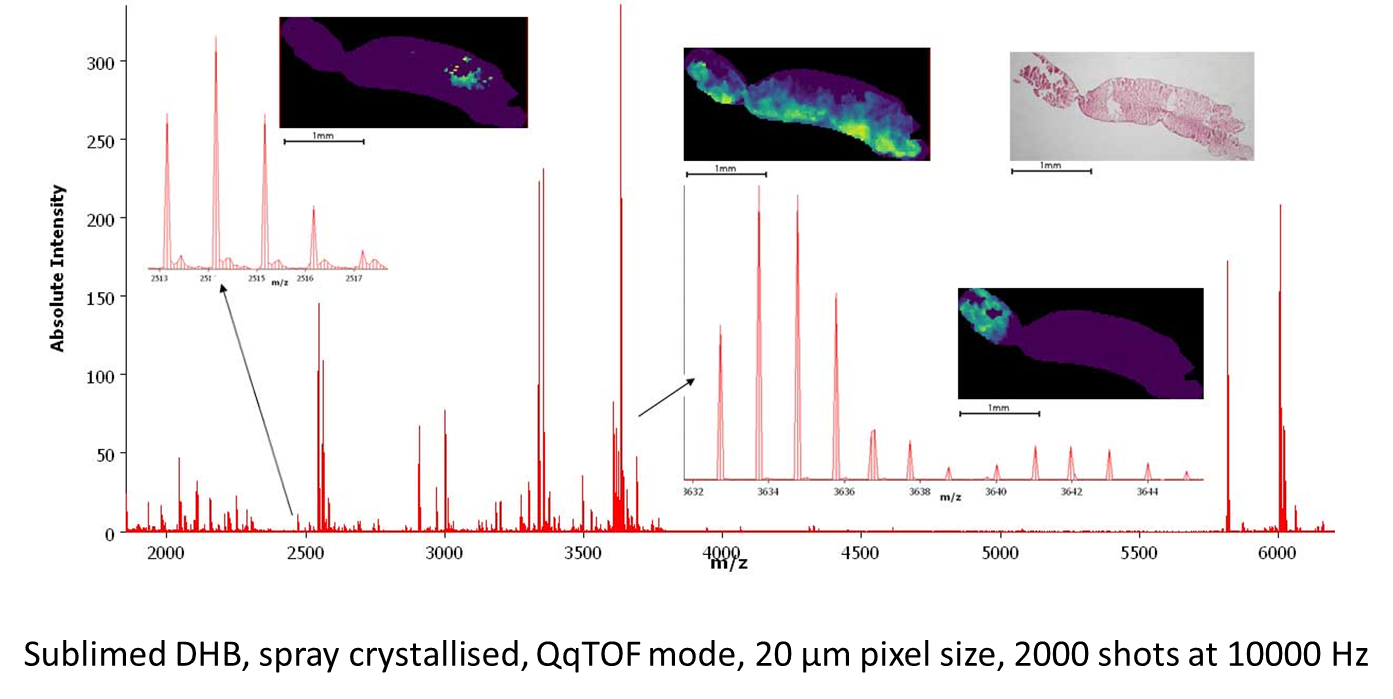The Centre for Microscopy and Microanalysis is pleased to announce the installation of the Bruker TIMS TOF Flex – MALDI-2. This is the first of these instruments to be installed in Australia and has already been touted as a paradigm-changing instrument for Mass Spectrometry Imaging. The instrument was funded through Microscopy Australia (NCRIS), and will be available to researchers via CMM, as per other Microscopy Australia funded equipment at UQ-CMM.
The Bruker TIMS TOF Flex – MALDI-2 is the first commercially available instrument to combine MALDI with a post-ionisation laser, referred to as MALDI-2. The TIMS TOF Flex with MALDI -2 combines all the abilities of the TIMS TOF Pro 2 with MALDI capability. Essentially the TIMS TOF Flex MALDI-2 can be a total solution for experiments requiring Mass Spectrometry Imaging and LC-MS approaches.
The instrument builds upon QqTOF technology adding trapped ion mobility (TIMS), allowing for collisional cross section (CCS) measurements. This can be used in a number of ways, including separation of isomers prior to QqTOF measurement – allowing for the observation of isomeric or isobaric species that were otherwise inseparable.
The other feature is the parallel accumulation serial fragmentation (PASEF) mode, whereby TIMS tunnel 1 accumulates ions (100ms), and TIMS tunnel 2 releases them sequentially (10+ precursors/100ms) – allowing for separate MSMS spectra to be collected as the ions are released from TIMS tunnel 2 Combined with the high speed QqTOF, this instrument is able to acquire many more MSMS spectra. Greater sensitivity is due to the accumulation of ions in TIMS tunnel 1 followed by the concentration and sequential release of precursor from TIMS tunnel 2.
This PASEF feature can be used as a data dependant acquisition (ddaPASEF) or data independent acquisition (diaPASEF). The instrument can also be used in TIMS off mode – as a regular QqTOF. These works flow can be applied to bottom up proteomics, lipidomics and metabolomics. The instrument can be coupled to either a Thermo Vanquish Flex UHPLC for lipids and Metabolites, or a Thermo RSLC nano for nanoLC based proteomic analyses. Data is searched using PEAKS Studio X, or Metaboscape. Mascot and MaxQuant can also be used.
The MALDI aspect of the instrument involves a primary laser operable up to 10000 Hz at 355nm, and a post-ionisation laser operable up to 1000 Hz at 266 nm. The post ionisation to-date has been found to be very useful for lipids and metabolites. For Mass Spectrometry Imaging experiments, the TIMS TOF Flex - MALDI-2 can be operated with or without post ionisation laser, and also as TIMS on or TIMS off. The other important aspect of the TIMS TOF Flex – MALDI -2 is the decoupling of the sample topography from the resulting mass resolution and mass accuracy, by virtue of the orthogonal acceleration of ions into the TOF analyser. This has the net result of radically improving the mass accuracy and mass resolution achievable during MSI experiments. Typically, the measurement is very close, if not exact, at the 2nd decimal place, and additionally the water cooled TOF analyser maintains a very stable mass accuracy measurement. The acquired data is visualised using SCILS LAB software, and in the case of lipids and metabolities, analyte annotation can be performed using Metaboscape. Utilising Metaboscape for both LC-MS and MSI work flows allows for much improved combination of the complimentary LC-MS and MSI datasets – combining the quantitative aspects of LC-MS with the spatial distributions aspects of MSI.
Below is some example MSI data shown for a centipede venom gland, using the TIMS TOF Flex in QqTOF mode at 20µm pixel size. In particular, we can see an example of the very high dynamic range of the instrument and MSI data is shown to be achieved for the high and the low abundance species.
The Figure below shows an example peptide in the venom gland of the centipede, its spatial distribution (A), the observed averaged spectrum (B), the simulation of the expected spectrum (C), and a table (D) showing the accuracy for each of the peaks in the isotope envelope – all of which are extremely close. This highlights the excellent mass accuracy and resolution possible at higher m/z values on the TIMS TOF Flex - MALDI-2.
The Figure below show MSI analysis of a saggital rat brain section, which was coated with 2,5-Dihydroxybenzoic Acid using the Sunchrom sprayer. The MSI experiment was conducted at 20 µm pixel size in QqTOF mode using the TIMS TOF Flex - MALDI-2 (without post ionisation). The images (A) are the distributions for some species observed during the analysis. The pictures in (B) show some example data acquired at 5 µm pixel size from the same piece of tissue.
MSI for lipids, metabolites, peptides, and small proteins, all at high mass accuracy, will be possible with this instrument.
Overall, the TIMS TOF Flex - MALDI-2 has caused a positive disruptive influence in the MSI community and UQ-CMM are fortunate to be able to provide access to this innovative technology.
The Bruker TIMS TOF Flex - MALDI-2 is now available for use at the Centre for Microscopy and Microanalysis, in the same openly accessible manner as other existing infrastructure within CMM. Once trained, users can book and use the instrument at the Hawken Lab (Bld 50).
Location: Hawken Building #50 (Room L106)
Contact: Brett Hamilton: b.hamilton@uq.edu.au








